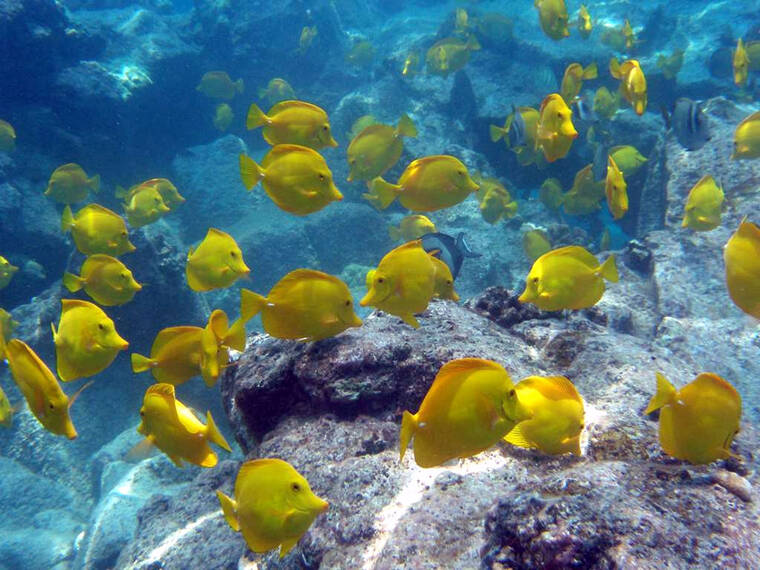Fate of West Hawaii commericIal aquarium fishing hangs on state High Court judgment
Oral arguments over the fate of commercial aquarium fishing in West Hawaii waters will be heard by the Hawaii Supreme Court on Dec. 5.
The lawsuit was originally filed in 2021 by Earthjustice on behalf of a coalition of conservation groups, Native Hawaiian fishermen and cultural practitioners.
Plaintiffs listed in the lawsuit include Willie Kaupiko, a former member of the West Hawaii Fisheries Council and a longtime konohiki (caretaker) of the fisheries fronting Milolii Village; Kaimi Kaupiko, a Native Hawaiian cultural practitioner and subsistence fisherman; Mike Nakachi, a cultural practitioner who leads scuba diving tours; For the Fishes, a nonprofit committed to reef ecosystems; the nonprofit Center for Biological Diversity and Kai Palaoa, an unincorporated association of Native Hawaiian religious and cultural practitioners.
The suit was filed objecting to the approval of an environmental impact statement supporting the harvesting of tropical fish for the aquarium industry despite ongoing litigation over the issue.
The plaintiffs filed the complaint against the Board of Land and Natural Resources and the Department of Land and Natural Resources for declaratory and injunctive relief in the First Circuit Court.
The state published a final environmental impact statement for the practice in West Hawaii waters in its Oct. 8, 2022. The EIS was deemed statutorily approved because the Board of Land and Natural Resources, the approving agency, did not make a determination within the 30 days allotted by law. The board in 2021 deadlocked 3-3 on the revised EIS submitted by the Pet Industry Joint Advisory Council.
Under the revised EIS, the number of commercial aquarium fishing permits issued in the West Hawaii Regional Fishery Management Area was cut from 10 to seven and the allowable commercial catch reduced from 40 to eight species. Under the plan, only yellow tang, kole, orangespine unicornfish, potter’s angelfish, brown surgeonfish, Thompson’s surgeonfish, black surgeonfish and bird wrasse would be allowed to be taken.
The plaintiffs alleged the state’s decision to accept the revised final EIS regarding the West Hawaii Regional Fishery Management Area violated the Hawaii Environmental Policy Act. The fishery management area spans the entire coastline of West Hawaii, from Upolu Point in North Kohala to Ka Lae (South Point) in Ka‘u.
The plaintiffs asked the Circuit Court to issue a declaratory judgment that the revised final EIS failed to comply with HEPA and the Hawaii Administrative Rules prohibit the agencies from issuing aquarium permits to collectors seeking coverage under the revised final EIS.
The Circuit Court determined “the revised final EIS provided sufficient information to enable the Board to make an informed and reasoned decision,” and denied the motion.
On appeal, the plaintiffs argued that the Circuit Court erred in concluding that the revised final EIS amounted to a valid HEPA review because the body of the document did not discuss public comments and comment responses, and only included such information as appendices. They also asserted that the revised final EIS failed to meet HEPA’s content requirements.
“That’s why we appealed. They did not deal with any negative and cumulative impacts of what the industry has done,” said Nakachi.
An Oahu Circuit Court judge in January lifted an injunction prohibiting the issuance or renewal of aquarium fishing permits for West Hawaii waters, however no permits have been issued.
The injunction, imposed in 2017 in a case known as the “Umberger case” that challenged the acceptance of a final EIS for the trade, was lifted because the environmental review pursuant to the HEPA was complete for the West Hawaii Regional Fishery Management Area, the state said. That case will also be heard by the high court.
“At least they are off the reefs right now. There is an embargo so no one can take aquarium fish because there are no permits right now. But you have to understand 50 years of damage has already taken place,” Nakachi explained.
He said all of the near-shore fish are public trust resources.
“COVID brought us together because people needed to feed their family, go poke some fish and go home and eat the fish. That’s what public trust is for. It’s not for the guy who has a commercial license that can go and take 2,000 fish a day. That’s wrong,” he said. “There was one thing only that was driving it … dollars. Who is it to say our resources are supposed to be pimped out for the benefit of an extractive wildlife trafficking business.”
Legislation was introduced in the last session to prohibit harvesting of aquatic life for commercial aquarium purposes, but both the state House and state Senate versions died.
“A lot of kamaaina are advocating for our home,” said Nakachi. “We want the fish here in perpetuity. I’m going to keep on advocating because it’s the right thing to do.”


